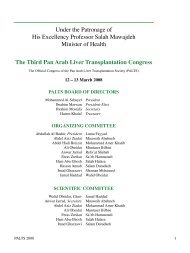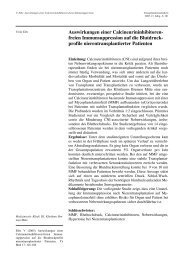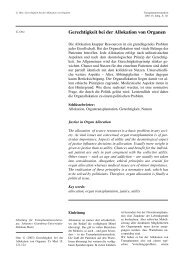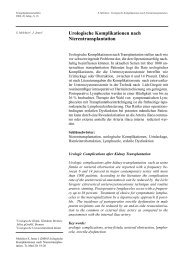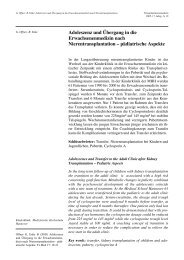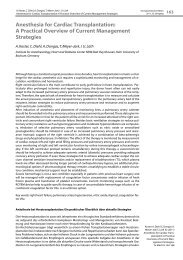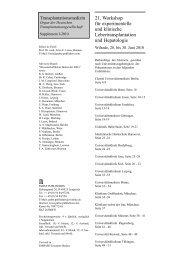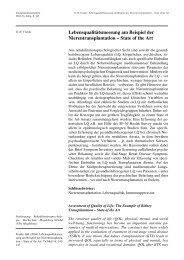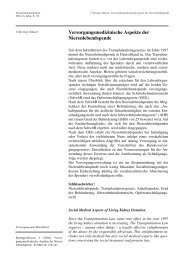Pädiatrische Lebertransplantation 2011 - Transplantation.de
Pädiatrische Lebertransplantation 2011 - Transplantation.de
Pädiatrische Lebertransplantation 2011 - Transplantation.de
Erfolgreiche ePaper selbst erstellen
Machen Sie aus Ihren PDF Publikationen ein blätterbares Flipbook mit unserer einzigartigen Google optimierten e-Paper Software.
8<br />
<strong>Transplantation</strong>smedizin<br />
<strong>2011</strong>, 23. Jahrgang<br />
R. Ganschow<br />
Pädiatrische <strong>Lebertransplantation</strong> <strong>2011</strong><br />
rung von Patienten ermöglichen, bei <strong>de</strong>nen die<br />
Immunsuppression abgesetzt wer<strong>de</strong>n kann.<br />
Ebenso fehlen prädiktive klinische und laborchemische<br />
Marker für die Entwicklung einer<br />
chronischen <strong>Transplantation</strong>dysfunktion, <strong>de</strong>ren<br />
Pathogenese letztendlich immer noch unklar<br />
ist.<br />
Bezüglich <strong>de</strong>r Situation in Deutschland wer<strong>de</strong>n<br />
wir in <strong>de</strong>n kommen<strong>de</strong>n Jahren vermehrt junge<br />
Erwachsene, welche im Kin<strong>de</strong>salter lebertransplantiert<br />
wur<strong>de</strong>n, für eine Re-Ltx zu listen haben,<br />
wobei aufgrund eines nunmehr fehlen<strong>de</strong>n<br />
„Bonus“ mit sehr langen Wartezeiten zu<br />
rechnen ist. Be<strong>de</strong>nklich auch die Tatsache, dass<br />
aktuell eine zu große Zahl von <strong>Transplantation</strong>szentren<br />
sich mit <strong>de</strong>r Kin<strong>de</strong>rlebertransplantation<br />
beschäftigt, ohne dass transparente<br />
Qualitätsmerkmale für die Qualifikation nachgewiesen<br />
wer<strong>de</strong>n müssen. Diesbezüglich sind<br />
nicht nur übergeordnete gesetzliche Vorgaben<br />
anzustreben, son<strong>de</strong>rn die Pädiatrischen Hepatologen<br />
sind in <strong>de</strong>r Pflicht, ein bun<strong>de</strong>s<strong>de</strong>utsches<br />
Register ebenso wie möglichst einheitliche<br />
Behandlungsprotokolle sowie eine Zentrumszertifizierung<br />
anzustreben. Der Gesamterfolg<br />
einer Ltx im Kin<strong>de</strong>salter ist unzweifelhaft<br />
von einer professionellen, interdisziplinären<br />
Zusammenarbeit abhängig und nur mit dieser<br />
wer<strong>de</strong>n auch zukünftige, neue Herausfor<strong>de</strong>rungen<br />
<strong>de</strong>r <strong>Lebertransplantation</strong> im Kin<strong>de</strong>sund<br />
Jugendalter zu bewältigen sein.<br />
Literatur<br />
1. Grabhorn E, Schulz A, Helmke K et al. (2004) Shortand<br />
long-term results of liver transplantation in<br />
infants aged less than 6 months. <strong>Transplantation</strong><br />
78: 235-241<br />
2. Hansen K, Horslen S (2008) Metabolic liver disease<br />
in children. Liver <strong>Transplantation</strong> 14: 391-411<br />
3. Broering DC, Mueller L, Ganschow R et al. (2001) Is<br />
there still a need for living-related liver transplantation<br />
in children? Ann Surg 234: 713-722<br />
4. Broering DC, Kim JS, Mueller T et al. (2004) Onehundred<br />
thirty-two consecutive pediatric liver<br />
transplants without hospital mortality: Lessons<br />
learned and outlook for the future. Ann Surg 240:<br />
1002-1012<br />
5. Kamath BM, Olthoff KM (2010) Liver transplantation<br />
in children: Update 2010. Pediatr Clin N Am<br />
57: 401-414<br />
6. El Moghazy WM, Ogura Y, Mutsuko M et al. (2010)<br />
Pediatric living-donor liver transplantation for<br />
acute liver failure: analysis of 57 cases. Transplant<br />
Int 23: 823-830<br />
7. Norris S, Houlihan D (2008) Liver transplantation<br />
in HIV-positive patients. Expert Rev Gastroenterol<br />
Hepatol 2: 39-46<br />
8. Martin SR, Atkinson P, Anand R, Lindblad AS<br />
(2002) Studies of pediatric liver transplantation<br />
2002: patient and graft survival and rejection in<br />
pediatric recipients of a first liver transplant in the<br />
United States and Canada. Pediatr <strong>Transplantation</strong><br />
8: 273-283<br />
9. Hasenbein W, Albani J, Englert C et al. (2006)<br />
Long-term evaluation of cyclosporine and tacrolimus<br />
based immunosuppression in pediatric<br />
liver transplantation. Pediatr <strong>Transplantation</strong> 10:<br />
938-942<br />
10. Ganschow R, Grabhorn E, Schulz A et al. (2005).<br />
Long-term results of basiliximab induction immunosuppression<br />
in pediatric liver transplant recipients.<br />
Pediatr <strong>Transplantation</strong> 9: 741-745<br />
11. Kelly D, Jara P, Ro<strong>de</strong>ck B et al. (2004) Tacrolimus<br />
and steroids versus cyclosporine microemulsion,<br />
steroids, and azathioprine in children un<strong>de</strong>rgoing<br />
liver transplantation: randomized European<br />
multicentre trial. Lancet 364: 1054-1061<br />
12. Spada M, Petz W, Bertani A et al. (2006) Randomized<br />
trial of basiliximab induction versus steroid<br />
therapy in pediatric liver allograft recipients un<strong>de</strong>r<br />
tacrolimus immunosuppression. Am J Transplant<br />
6: 1913-1921<br />
13. Brinkert F, Kemper MJ, Briem-Richter A et al<br />
(2010). High prevalence of renal dysfunction in<br />
children after liver transplantation: non-invasive<br />
diagnosis using a cystatin C-based equation.<br />
Nephrol Dial Transplant Sep 8 (Epub ahead of<br />
print)<br />
14. Varo E, Lopez A, Rivero C (2002) Initial immunosuppression<br />
in liver transplant recipients with impaired<br />
renal function. Transplant Proc 37: 3909-<br />
3912<br />
15. Harambat J, Ranchin B, Dubourg L et al. (2008).<br />
Long-term renal function in children after liver<br />
transplantation. <strong>Transplantation</strong> 86: 1028-1034<br />
16. Krampe K, Briem-Richter A, Fischer L, Nashan B,<br />
Ganschow R (2010) The value of immunoprophylaxis<br />
for cytomegalovirus infection with intravenous<br />
immunoglobulin in pediatric liver transplant<br />
recipients receiving a low-dose immunosuppressive<br />
regimen. Pediatr <strong>Transplantation</strong> 14:<br />
67-71<br />
17. Lapidus-Krol E, Shapiro R, Amir J et al. (2010) The<br />
efficacy and safety of valganciclovir vs. oral ganciclovir<br />
in the prevention of symptomatic CMV infection<br />
in children after solid organ transplantation.<br />
Pediatr <strong>Transplantation</strong> 14: 753-760<br />
18. Ganschow R, Schulz T, Meyer T et al. (2004) Lowdose<br />
immunosuppression reduces the inci<strong>de</strong>nce<br />
of posttransplant lymphoproliferative disease in<br />
pediatric liver graft recipients. J Pediatr Gastroenterol<br />
Nutr 38: 198-203<br />
19. Melter M (2007) Pädiatrische <strong>Lebertransplantation</strong>en.<br />
Eingriffe auf spezielle Zentren beschränken.<br />
Deutsches Ärzteblatt 23: A1-A7<br />
20. Sze YK, Dhawan A., Taylor RM et al. (2009) Pediatric<br />
liver transplantation for metabolic liver disease:<br />
Experience at King`s College Hospital. <strong>Transplantation</strong><br />
87: 87-93<br />
21. Stuchfield BM, Forbes SJ, Wigmore SJ (2010) Prospects<br />
for stem cell transplantation in the treatment<br />
of hepatic disease. Liver <strong>Transplantation</strong> 16:<br />
827-836<br />
22. Al-Sinani S, Dhawan A (2008) Corticosteroids usage<br />
in pediatric liver transplantation: To be or not<br />
to be! Pediatr <strong>Transplantation</strong> 13: 160-170<br />
23. Dell-Olio D, Kelly DA (2009) Calcineurin inhibitor<br />
minimization in pediatric liver allograft recipients.<br />
Pediatr <strong>Transplantation</strong> 13: 670-681<br />
24. Ekong UD, Bhagat H, Alonso EM (2010) Once daily<br />
calcineurin inhibitor monotherapy. Am J <strong>Transplantation</strong><br />
10: 883-888




